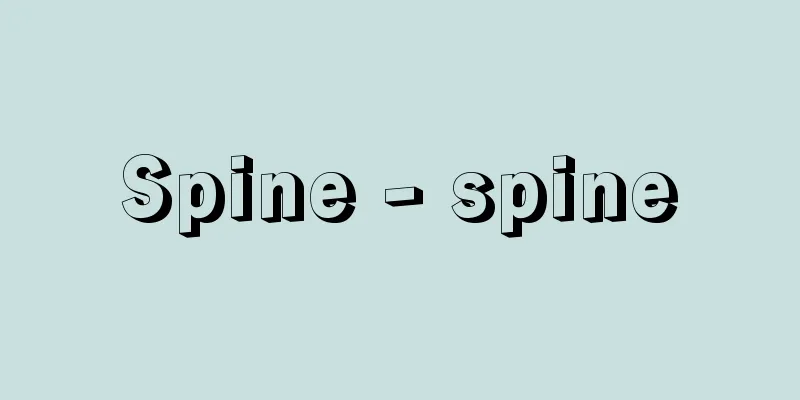Spine - spine

|
In vertebrates, this refers to the main part of the axial skeleton that continues behind the skull. From the vertebral column extend the appendages, i.e. the bones that support the limbs or fins, via the shoulder and pelvic girdles. The vertebral column develops around the notochord and is composed of segmented vertebrae (generally called vertebrae), but in agnathopods (cyclostomes), the vertebrae are primitive, with only a few pieces of cartilage forming on the dorsal surface of the notochord. In cartilaginous fish, the cartilaginous vertebral body (the cylindrical central part of the vertebrae) that surrounds the notochord continues throughout life, but in bony fish and higher animals, it hardens into bone. In higher vertebrates where the vertebrae are well developed, the notochord shrinks and only a small amount of cartilage remains between the vertebrae. In fish, the differentiation of the vertebrae is not clear, but in amphibians and higher, the shape differs depending on the part of the vertebral column, and from the skull side, the cervical, thoracic, lumbar, sacral, and caudal vertebrae can be distinguished. [Seiichiro Kawashima] Human spineThe human spinal column, commonly called the backbone, is made up of 32 to 35 vertebrae. The average length of the spinal column in Japanese people is 75 centimeters. The spinal canal is formed in the center of the spinal column by a series of vertebral foramina in each vertebra, and contains the spinal cord. The upper end of the spinal canal continues to the cranial cavity through the foramen magnum at the base of the skull. As a result of our bipedal lifestyle, the human spine shows a unique curvature that differs from that of quadrupeds. In infants, the entire spine shows a slight kyphosis (convex backwards), but as we grow, the need arises to support the head and trunk, and by adulthood the cervical and lumbar regions show a lordosis (convex forwards), and the thoracic and sacral regions show a kyphosis. This state is called physiological curvature. This physiological curvature changes slightly over the course of a day and depending on whether we are lying down or standing. If unnatural weight is placed on the spine during development, it will develop an abnormal curvature. If there is a strong thoracic kyphosis, it will result in kyphosis (round back), and if it becomes a partial protrusion, it will result in hunchback. Also, if there is a strong left-right curvature of the spine, it will result in scoliosis. Note that the length of the spine is not necessarily proportional to height. [Kazuyo Shimai] [Reference] |©Shogakukan "> Names of parts of the spine Source: Shogakukan Encyclopedia Nipponica About Encyclopedia Nipponica Information | Legend |
|
脊椎(せきつい)動物において頭骨の後方に続く中軸骨格の主要部分をいう。脊柱から肩帯および腰帯を介して四肢またはひれを支える骨、すなわち付属骨格が伸びている。脊柱は脊索を中心に発達し、分節的な椎骨(一般には脊椎骨の名称でよばれる)で構成されるが、無顎(むがく)類(円口類)では椎骨は原始的で、脊索背面に軟骨片がわずかに生じるだけである。軟骨魚類では脊索を囲む軟骨性の椎体(椎骨の中央の円筒状部分)が終生続くが、硬骨魚類以上の動物では硬骨化する。椎骨が発達する高等脊椎動物では、脊索は縮小し軟骨部分は椎骨間にわずかに残る。魚類では椎骨の分化は明瞭(めいりょう)でないが、両生類以上では脊柱の部分により形態が異なり、頭骨側から頸椎(けいつい)、胸椎、腰椎、仙椎、尾椎が区別できる。 [川島誠一郎] ヒトの脊柱ヒトの脊柱は俗に背骨ともよばれ、32~35個の椎骨から構成される。また、脊柱の長さは、日本人で平均75センチメートルである。脊柱の中心には、個々の椎骨に存在する椎孔の連続によって脊柱管が形成され、内部に脊髄を入れている。脊柱管の上端は頭蓋底(とうがいてい)の大後頭孔を通じて頭蓋腔(くう)に続いている。ヒトの脊柱は、二足歩行の生活の結果、四足動物とは異なる特有の彎曲(わんきょく)を示す。すなわち、乳幼児では脊柱全体が軽い後彎(後方に凸)を示すが、成長するにつれて頭部および体幹を支持する必要が生じ、成人になると頸部(けいぶ)と腰部とは前彎(前方に凸)、胸部と仙部とは後彎を示すようになる。この状態を生理的彎曲という。こうした生理的彎曲は、1日の時間の経過や起臥(きが)によって多少変化する。発育の途上で脊柱に不自然な荷重がかかると異常彎曲を生じる。胸部の後彎が強い場合には後彎症(円背(えんぱい))となり、それが部分的な突出になると亀背(きはい)となる。また、脊柱の左右の彎曲が強いと側彎となる。なお、脊柱の長さと身長とはかならずしも比例しない。 [嶋井和世] [参照項目] |©Shogakukan"> 脊椎の各部名称 出典 小学館 日本大百科全書(ニッポニカ)日本大百科全書(ニッポニカ)について 情報 | 凡例 |
>>: Underground gasification of coal
Recommend
Insurance contract - hokenkeiyaku (English spelling) contract of insurance
It refers to a contract to realize insurance. In ...
Armalcolite
This mineral was first discovered in the lunar sam...
Mulhouse - Mulhouse (English spelling)
The sub-prefecture capital of the Haut-Rhin depar...
Assaka
…The term mahājanapada translates to “great count...
Cotyledon - Let's try
The first leaves produced by the developing embry...
Poison Arrow - Dokuya
〘 noun 〙① An arrow with a poisoned tip. Poison arr...
Tungsten Bronze
The general formula is M I x WO 3 . It is one of t...
FM - FM
Facility management is a management method for eff...
Usutabiga - Thin Tabiga
A large moth belonging to the order Lepidoptera a...
Language
…These tissues, along with the palatine tonsils a...
BAT Industries [Company] - BAT Industries (English spelling) BAT Industries PLC (Public Limited Company)
The world's largest tobacco manufacturer, with...
Gniezno (English spelling)
A commercial city in the Wielkopolskie Voivodeship...
Nevel'skoi, GI (English spelling)
...Population: 36,500 (1992). Founded in 1850 by ...
Akitsugawa
...Tanabe Castle is located on the left bank of t...
Kurume Kasuri
Kurume City, Fukuoka Prefecture, is the center of...





![Kilimanjaro [Mountain] - Kilimanjaro](/upload/images/67cb61460357c.webp)



